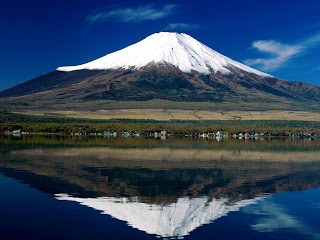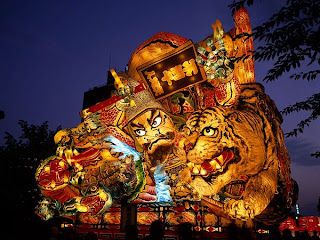
TOKYO —Actor Junichi Ishida, 56, held a talk show recently for 125 couples planning to tie the knot. He lectured them on how to keep things going smoothly, explaining, “I fight with my wife too. A few days ago we were going somewhere in a hurry, so I tried to get on the expressway, but she yelled at me, ‘That’s a waste of time!’ In essence, it’s all about being considerate.”
Ishida also revealed plans to release a book together with famous neuroscientist Kenichiro Mogi.
News from Japan Today
Saturday, May 8, 2010
Ins and Outs of Marriage
Labels: beginner, entertainment, family, marriage
Posted by jo at Saturday, May 08, 2010 0 comments
Going green with nuclear power

The Nuclear Safety Commission and the Atomic Energy Commission have issued their annual reports for 2009, in which they call for the promotion of nuclear energy as an important means of fighting global warming. Nuclear power plants do not emit carbon dioxide while operating.
The reports came as the Hatoyama administration is pushing a policy of reducing greenhouse gas emissions 25 percent from 1990 levels by 2020. Under the Kyoto Protocol, Japan agreed to slash emissions by 6 percent from 1990 levels during the 2008-2012 period, but present levels still exceed those of 1990.
To both reduce CO2 emissions and increase the supply of electricity, the NSC and the AEC call for improving the operation rate of Japan's 54 nuclear power plants, which produce about 30 percent of the nation's electricity.
In the 1990s, the plants' average operation rate was around 80 percent. But from 2007 it dropped to around 60 percent. In contrast, nuclear power plants in Europe, North America and South Korea have enjoyed an operation rate of 80 percent to 90 percent throughout the past decade. The safety commission says that a 1 percent improvement in the operation rate would be equivalent to a reduction of some 3 million tons of CO2 annually. It is estimated that if the operation rate returns to 80 percent, Japan will be able to reduce its CO2 emissions by about 5 percent.
But improving the operation rate will not be an easy job. Eighteen — or one third — of Japan's 54 reactors are more than 30 years old, and one is 40 years old. Another will turn 40 this year. Pipes and reactor components are deteriorating rapidly in nuclear power plants built in the 1960s and '70s.
The safety commission calls for lengthening the interval between regular checks of nuclear power plants, prolonging the operational life of such plants to more than 40 years and increasing their output by about 5 percent — all steps that increase safety risks. A series of mishaps at nuclear power plants has lowered people's trust. In its pursuit of an improved operation rate, the nuclear power industry must take every possible step to ensure that safety is not compromised.
Editorial from Japan Times
Labels: advance, environment, nuclear power
Posted by jo at Saturday, May 08, 2010 0 comments
Mt. Fuji

Photographers gathered before dawn to capture pictures of the sun reflecting off Lake Tanukiko after rising at the peak of Mount Fuji in Fujinomiya, Shizuoka Prefecture.
The sunrise glare on the summit Monday is a phenomenon known as "Diamond Fuji."
It was a particularly auspicious day because an absence of wind left the surface of the lake as smooth as glass, creating a breathtaking reflection.
The phenomenon can be seen for several days in late April and late August each year. It was expected to last until around Wednesday.
News from Asahi Shimbun
Labels: beginner, italk, mt fuji
Posted by jo at Saturday, May 08, 2010 0 comments
The Importance of Reading
The Importance of Reading
It is a well-known fact that when there were no televisions or computers, reading was a primary leisure activity. People would spend hours reading books and travel to lands far away-in their minds. The only tragedy is that, with time, people have lost their skill and passion to read. There are many other exciting and thrilling options available, aside from books. And that is a shame because reading offers a productive approach to improving vocabulary and word power. It is advisable to indulge in at least half an hour of reading a day to keep abreast of the various styles of writing and new vocabulary.
It is observed that children and teenagers who love reading have comparatively higher IQs. They are more creative and do better in school and college. It is recommended that parents to inculcate the importance of reading to their children in the early years. Reading is said to significantly help in developing vocabulary, and reading aloud helps to build a strong emotional bond between parents and children. The children who start reading from an early age are observed to have good language skills, and they grasp the variances in phonics much better.
Reading helps in mental development and is known to stimulate the muscles of the eyes. Reading is an activity that involves greater levels of concentration and adds to the conversational skills of the reader. It is an indulgence that enhances the knowledge acquired, consistently. The habit of reading also helps readers to decipher new words and phrases that they come across in everyday conversations. The habit can become a healthy addiction and adds to the information available on various topics. It helps us to stay in-touch with contemporary writers as well as those from the days of yore and makes us sensitive to global issues.
by Damian Sofsian
Labels: advance, intermediate, italk
Posted by jo at Saturday, May 08, 2010 0 comments
Photo Essay: Innocence and War
Ruined Body
Writing with a Crippled Hand
Smile
A New Bed!
A Happy Family
Deanne Fitzmaurice Photography
She won the 2005 Pulitzer Prize for Photojournalism
Labels: advance, global issues, italk, photo essay, war
Posted by jo at Saturday, May 08, 2010 0 comments
Thursday, May 6, 2010
Naruto Whirlpool

NARUTO, Tokushima Prefecture--A famous whirlpool in the Naruto Strait drew crowds of sightseers Sunday as relatively calm conditions and strong tides created a huge vortex.
The whirlpool between Shikoku and Awajishima island in Hyogo Prefecture reached a diameter of 15 meters shortly after 2 p.m. on Sunday. During the afternoon and evening, tourist boats crowded into the narrow straight to watch the spectacle.
Uzu no Michi (road of whirlpool), a tourist center run by Tokushima Prefecture and located under the Onaruto Bridge which crosses the strait, was also packed with visitors. According to Uzu no Michi, the whirlpool will reach its peak at 3:50 p.m. on Tuesday.
News from Asahi Shimbun
Labels: beginner, intermediate, italk, japan
Posted by jo at Thursday, May 06, 2010 0 comments
Japan: Its Culture and Attractions

A geisha stands with sealed lips symbolizing a code of honor. Entertaining Japan’s male elite through music, dance, song, and conversation, geisha are valued as much for discretion as for beauty. The famed icons of Japanese culture have practiced their gei, or art, for over 250 years.
Geisha
A brilliantly decorated lantern float stands out against the summer night sky during the Neputa Festival in Hirosaki. Often depicting warriors and shaped like fans, the floats are accompanied by traditional drums. Folk festivals featuring traditional music, dance, and costume are an important cultural element in Japan.
Sumo wrestlers clash in a ring in Nagoya. Once supported by the patronage of emperors, Japan’s national sport has roots going back nearly 1,500 years. Short but intense, most matches last less than a minute, with the grandly attired gyoji serving as referee.
Paper lanterns decorated with script glow orange in Japan. The Japanese language commonly uses 15,000 kanji characters, which are borrowed from Chinese. Schoolchildren as young as seven must confront the language’s complexities, such as learning to write some of the 200-plus characters for the sound “shou.”
Rice cakes, or mochi, are a favorite in Japan, particularly during the New Year, when they are traditionally given as gifts, set out decoratively in the home, or offered at shrines and temples. Their surfaces dusted with flour, the sticky, glutinous cakes are often stuffed with sweet beans or served in soup and, when not made by hand in a complex process, are widely available in supermarkets.
Photos are from National Geographic.
Labels: beginner, intermediate, italk, japan, teacher's life
Posted by jo at Thursday, May 06, 2010 0 comments
Japan: Its Culture and Attractions

Soaring bamboo stalks dwarf visitors to Arashiyama Park in western Kyoto. Known for its vertiginous growth, bamboo has numerous uses in Japan, particularly in Kyoto, where it is made into baskets, flutes, pipes, benches, dolls, garden fences, and artifacts for tea ceremonies.
Kyoto
Kinkakuji
Outside Shibuya Station in Tokyo, a crowd of pedestrians crosses a busy intersection beneath the glare of lighted billboards and neon signs. Japan’s capital is the planet's largest urbanized area, with some 36 million people.
Shibuya
Snowcapped Mount Fuji casts a bright spot on the frozen surface of Lake Yamanaka. The 12,388-foot (3,776-meter) volcano, which last erupted almost 300 years ago, is for the Japanese an enduring national symbol of serenity and strength. On a clear day, the iconic peak can be seen from Tokyo, 70 miles (112 kilometers) away.
Mt. Fuji
Standing at low tide, the torii on Miyajima is thrown into silhouette as the sun sinks behind a mountain. The famous vermilion gate was built in 1875 and is the largest in Japan, standing about 53 feet (16 meters) high. Torii are traditionally built as entrances to Shinto shrines.
Miyajima
Pictures are from National Geographic
Labels: beginner, intermediate, italk, teacher's life
Posted by jo at Thursday, May 06, 2010 0 comments
